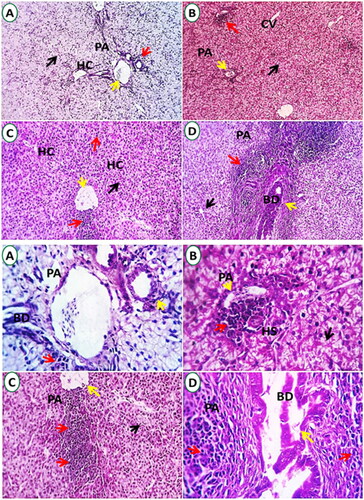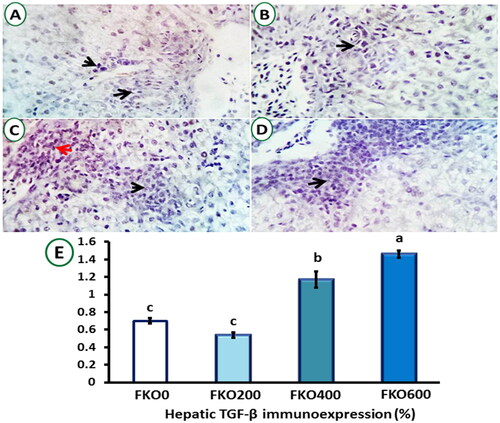Figures & data
Table 1. The proximate chemical constituents of the consumed basal diet (fed basis, g Kg−1).
Table 2. The retention time (RT) and peak area (%) of the chemical constituents contained in frankincense oil (FKO), as evidenced by GC-MS.
Table 3. The impact of dietary frankincense oil (FKO) supplementation on the growth of broiler chickens.
Table 4. The impact of dietary frankincense oil (FKO) supplementation on broiler chickens’ hepatic and renal function variables.
Table 5. The impact of dietary frankincense oil (FKO) supplementation on broiler chickens’ serum antioxidant activity and inflammatory responses.
Table 6. The impact of dietary frankincense oil (FKO) supplementation on serum lipid profile.
Figure 1. Photomicrographs of liver sections from chickens administered frankincense oil (FKO) at 0 mg kg−1 (A), 200 mg kg−1 (B), 400 mg kg−1 (C), and 600 mg kg−1 (D) exhibited typical histomorphological structures, like portal area (PA, yellow arrow), hepatocytes (HC, black arrow) which are perceived as a small masses around the Central veins (CV), a few round cells are seen as a natural immune response around the portal area (PA, arrow). mild to moderate portal lymphoplasmacytic aggregations (red arrows) and biliary proliferation (BD, yellow arrow) were seen in the FKO600 group. Each group with two magnification powers; H&E × 100, × 400.

Figure 2. The liver sections were immunostained for TGF-β positive cells (shown as red arrows) in the four experimental groups: (A) frankincense oil (FKO)0, (B) FKO200, (C) FKO400, and (D) FKO600. × 400 magnification power. (E) Quantitative analysis of the morphological features is as follows: 0.70%, 0.54%, 1.17%, and 1.46% for FKO0, FKO200, FKO400, and FKO600 groups, respectively.

Figure 3. The spleen sections were immunostained for TGF-β positive cells (showed as red arrows) in the four experimental groups: (A) frankincense oil (FKO)0, (B) FKO200, (C) FKO400, and (D) FKO600. × 400 magnification power. (E) Quantitative analysis of the morphological features is as follows: 0.50%, 1.72%, 1.73%, and 2.77% for FKO0, FKO200, FKO400, and FKO600 groups, respectively.

Data availability statement
The datasets generated or analyzed during the current study are not publicly available but are available from the corresponding author at reasonable request.
